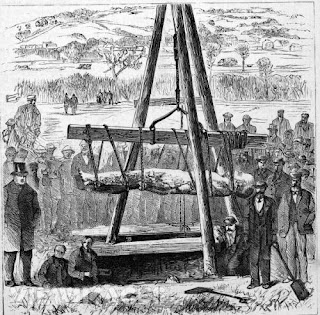When Gideon Mantell discovered
the teeth of Iguanodon in 1822, most palaeontologists and anatomists
disagreed with his identification (including, initially Cuvier) and one,
William Buckland, thought that they were either from a wolf-fish or maybe a
mammal that had drowned in Noah’s flood.
 |
| Buckland's Megatherium |
He urged Mantell to be cautious in
publishing his findings, advice which Mantell followed, but Buckland went on to
publish a description of another dinosaur himself, becoming the first person to
describe a dinosaur, the Megalosaurus, in print, (a fragment of a
fossilised femur found in a quarry in Cornwall in 1676, had been described by
Robert Plot in 1677, in his The Natural History of Oxfordshire, and was
thought to come from a human giant – in 1763, Robert Brookes examined the bone
and named it Scrotum Humanum – can you guess why?).
 |
| Scrotum Humanum - R Plot - The Natural History of Oxfordshire 1677 |
The Very Reverend Dr
William Buckland was odd, to say the very least. He caused quite a stir with
his explicit lectures on the mating habits of reptiles – The Times felt
he should restrain his enthusiasm ‘in the presence of ladies’ and
Charles Darwin dismissed him as a ‘buffoon’ – and he always wore his
academic gown when out digging for fossils. The hallway of his Oxford home was
lined with the skulls of animals; monkeys, a bear (in a mortarboard) and a
hyena, amongst other animals, had the run of the house (the hyena ate the
family’s guinea pig). His wife, Mary,
was a talented illustrator and shared her husband’s enthusiasm for
nature – one night, the pair got up from their bed and she prepared a flour and
water paste whilst he went off to fetch the family tortoise, in an experiment
to prove that the gait of the Cheirotherium was testudinal (… it was).
 |
| The Very Reverend Dr William Buckland |
But strangest of all was Buckland’s diet. He was a committed zoophagist – an
eater of animals. All animals. In Buckland’s opinion, the Creator had placed
the creatures of the world at Man’s service, to feed and clothe him and to be
his companions, and it was Man’s duty to eat the rich bounty of foods provided
by the Almighty for his sustenance. And eat them he did – from elephant trunk
soup, panther chops, horse tongue, porpoise head, crispy mice in batter,
kangaroo ham and eland steaks to accidentally grilled giraffe (… there had been
a fire at London Zoo). He found the taste of mole to be the worst, until he
tasted bluebottles.
Once, while touring a church, the local vicar showed him
‘martyr’s blood’ dripping from the rafters – Buckland dropped to his knees and
began to lap at the miraculous liquid, which was, he announced between laps,
bats’ urine. On a visit to Nuneham House, he was shown a silver casket holding
what was reputed to be the heart of King Louis XIV of France. Before anyone
could stop him, Buckland announced, “‘I have eaten many strange things, but
have never eaten the heart of a king before,” before snatching it up and
swallowing it.
 |
| Frank Buckland and dinner guest |
His son, Francis (known as Frank), continued and even extended
his father’s culinary experiments – he was rumoured to regularly visit
sympathetic staff at Winchester Hospital, with whom he exchanged trout and eels
for pieces of human anatomy. He founded the Acclimatization Society, which was
dedicated to finding new food sources, and he became famous for the varied
menus he offered at his home in Albany St, London.
 |
| Frank Buckland with what could be his lunch |
Frank Buckland went on to
become an eminent naturalist in his own right and became H.M. Inspector of Salmon
Fisheries in 1867, introducing many important innovations in fish farming.
William Buckland, despite Darwin’s misgivings, made some important
archaeological finds, including the discovery of the oldest human skeleton in
Britain and first human fossil ever excavated, the so-called Red Lady of
Paviland.
 |
| Goat's Hole Cave, Gower |
In 1823, he descended into the Goat’s Hole Cave on the Gower
Peninsula, Wales, where he unearthed the bones of an Upper-Palaeolithic man who
lived about 33,000 years ago. The bones were stained with red ochre deposits
from the clay in the cave, and the colour and accompanying beads, ivory rods
and seashells lead Buckland to initially identify the body as that of a female
prostitute from the Roman period of occupation (Buckland believed that no
humans could be older than Noah’s flood), although later examination has shown
that the skeleton is that of a young male, aged about twenty-one years of age.
It was the oldest ceremonial burial in Europe, the age confirmed by a series of
radiocarbon datings. Subsequent excavations in the cave have discovered over
4,000 flint tools and fragments, bones, teeth, bone needles and bracelets.
 |
| The 'Red Lady' of Paviland |
He wasn’t above the odd practical
joke – and not least from beyond the grave. After his death in 1856, it was
found that the plot that he had identified as his desired final resting place
in Islip graveyard, when the superficial soil had been removed, was solid
Jurassic limestone. The rock had to be blasted with gunpowder in order to make
the grave – a geologist of Buckland’s calibre would surely have known what lay
beneath the soil.
A student of Buckland's wrote:
If with Mattock and Spade his body we lay,In the common Alluvial soil,He'll start up and snatch those tools awayOf his own Geological toilIn a Stratum so young the Professor disdainsThat embedded should be his Organic Remains.















































